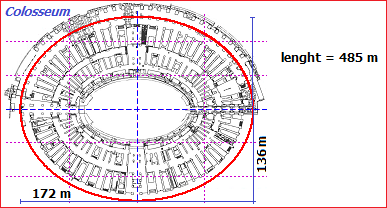

| First example. function x(t) { with(Math) { return t }} function y(t) { with(Math) { return sin(t) }} If I put n=1e4, a=-PI, b=PI I have 7.640395538638171. Then I get the above values. I can take: lenght = 7.64039557806 |  |
If I change x(t), y(t) I can If consider any curve.
Second example.
function x(t) { with(Math) {
return cos(t)*172/2
}}
function y(t) { with(Math) {
return sin(t)*136/2
}}
a = 0, b = 2PI

I can take: lenght = 485 m:

We can draw the graph with JavaScript; for example, see the script colosseum (see the code; se also here).
Third example.
A wire stretched between two pylons 50 meters apart has the shape of the catenary y = K/2*(exp(x/K)+exp(-x/K)) with K = 100 (m). What is the length of the wire?

function x(t) { with(Math) {
return t
}}
function y(t) { with(Math) {
K = 100;
return K/2*(exp(t/K)+exp(-t/K))
}}
50.52246336163236 if a=-25 b=25 n=64e4 [1.9113599591946695e-11]
50.52246336161325 if a=-25 b=25 n=16e4 [3.015969696207321e-10]
50.52246336131165 if a=-25 b=25 n=4e4 [4.83302642351191e-9]
50.522463356478625 if a=-25 b=25 n=1e4 [50.522463356478625]
Rounding, 50.52 m.
Fourth example.
Let us consider the curve in polar coordinates ρ = sin(θ/2)³,
θ in
ρ = f(θ) → x = f(θ)·cos(θ),
y = f(θ)·sin(θ).

function x(t) { with(Math) {
return pow(sin(t/2),3)*cos(t)
}}
function y(t) { with(Math) {
return pow(sin(t/2),3)*sin(t)
}}
7.151268506842977 if a=0 b=12.566370614359172 n=1024e4 [1.7691625942006795e-11]
7.151268506825286 if a=0 b=12.566370614359172 n=256e4 [2.7280133707563436e-10]
7.151268506552484 if a=0 b=12.566370614359172 n=64e4 [4.3619552414497775e-9]
7.151268502190529 if a=0 b=12.566370614359172 n=16e4 [6.97931170634547e-8]
7.151268432397412 if a=0 b=12.566370614359172 n=4e4 [0.0000011166891162872616]
7.151267315708296 if a=0 b=12.566370614359172 n=1e4 [7.151267315708296]
7.15126850684
We can draw the graph with JavaScript; for example, see the script polar (see the code; se also here).